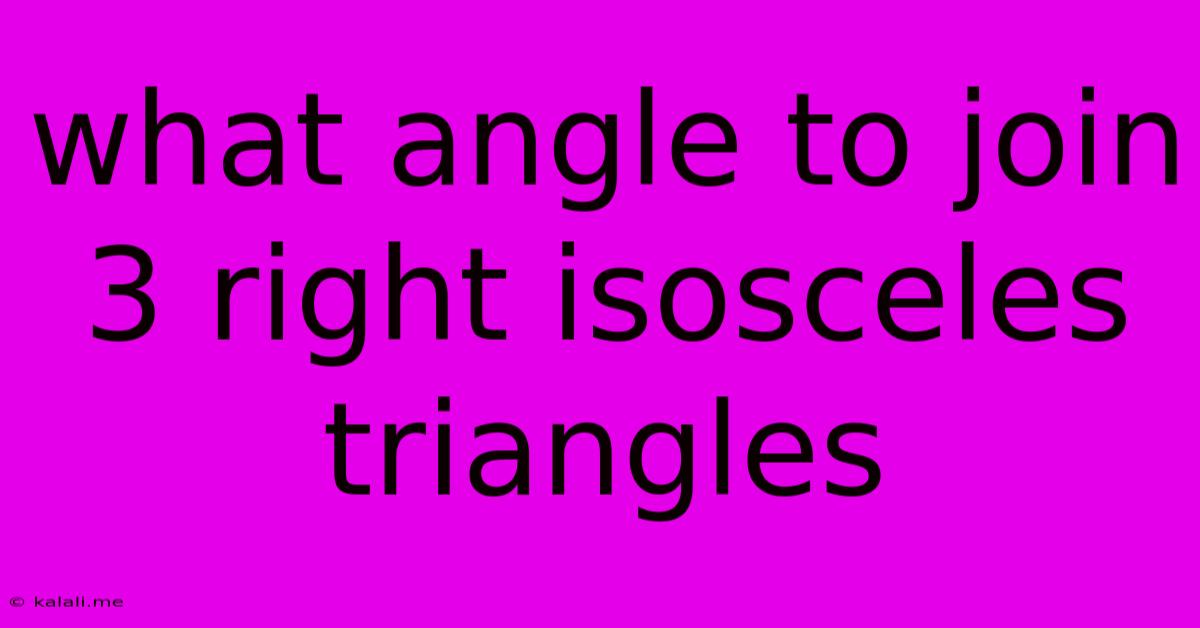What Angle To Join 3 Right Isosceles Triangles
Kalali
Jun 07, 2025 · 3 min read

Table of Contents
What Angle to Join 3 Right Isosceles Triangles? A Comprehensive Guide
This article explores the different ways to join three right isosceles triangles, examining the angles involved and the resulting shapes. We'll delve into the geometric principles involved, providing clear explanations and visual aids (though unfortunately, I can't display images directly). Understanding this helps in various applications, from creating tessellations to solving geometric puzzles. Think of it as a fundamental building block for more complex geometric constructions.
Understanding Right Isosceles Triangles
A right isosceles triangle is a triangle with one 90-degree angle and two equal angles (each measuring 45 degrees). The two sides opposite the equal angles are equal in length. This inherent symmetry is key to understanding how these triangles can be joined.
Methods of Joining Three Right Isosceles Triangles
There are several ways to join three right isosceles triangles, each resulting in a different shape and using different angles. Let's explore the most common:
1. Joining at the Right Angle: Forming a Larger Triangle
This method involves joining the three triangles such that their right angles are connected to form a larger isosceles triangle. The resulting triangle is simply a scaled-up version of the original right isosceles triangle.
- Angle of Joining: 90 degrees at the central point.
- Resulting Shape: A larger right isosceles triangle.
- Applications: This is a simple method frequently used in introductory geometry exercises and for creating larger, similar shapes.
2. Joining at the Hypotenuse: Forming a Hexagon
Another method involves joining the three triangles such that their hypotenuses (the side opposite the right angle) form a regular hexagon. To achieve this, the angles need to be carefully manipulated. Remember, the angles in a hexagon add up to 720 degrees.
- Angle of Joining: 120 degrees at the points where the hypotenuses meet. Each pair of adjacent triangles will share a 60 degree angle.
- Resulting Shape: A regular hexagon.
- Applications: Creating tessellations, exploring symmetry, and solving geometric problems related to regular polygons.
3. Joining to Form Other Shapes: Exploring Variations
The possibilities are numerous. Instead of focusing solely on regular polygons, you can form irregular shapes by strategically adjusting the angles at which the triangles are joined. The resulting shape will depend entirely on the angle at which the triangles meet.
- Angle of Joining: Variable, depending on the desired outcome. This method requires a deeper understanding of angles and their summations.
- Resulting Shape: A wide variety of irregular shapes, depending on the angles at which the triangles are joined. The possibilities are quite extensive.
- Applications: Creating complex shapes for design projects, exploring non-standard geometric constructions, or solving geometric puzzles involving spatial reasoning.
Conclusion
Joining three right isosceles triangles offers a surprisingly diverse range of geometric possibilities. The key to understanding the process lies in manipulating the angles at which the triangles connect. From simple enlargements to the creation of hexagons and complex irregular shapes, the options are vast. Experimentation and practice are crucial for developing a strong grasp of these concepts. By exploring these methods, you deepen your understanding of geometric principles and gain valuable problem-solving skills.
Latest Posts
Latest Posts
-
How Do You Take Off Restricted Mode On Youtube
Jun 08, 2025
-
Why Apple Chargers Dont Work On Windowa
Jun 08, 2025
-
When To Paint Pressure Treated Lumber
Jun 08, 2025
-
Breaking Surface Tension Before Hitting Water
Jun 08, 2025
-
Do Baptist Believe In Speaking In Tongues
Jun 08, 2025
Related Post
Thank you for visiting our website which covers about What Angle To Join 3 Right Isosceles Triangles . We hope the information provided has been useful to you. Feel free to contact us if you have any questions or need further assistance. See you next time and don't miss to bookmark.